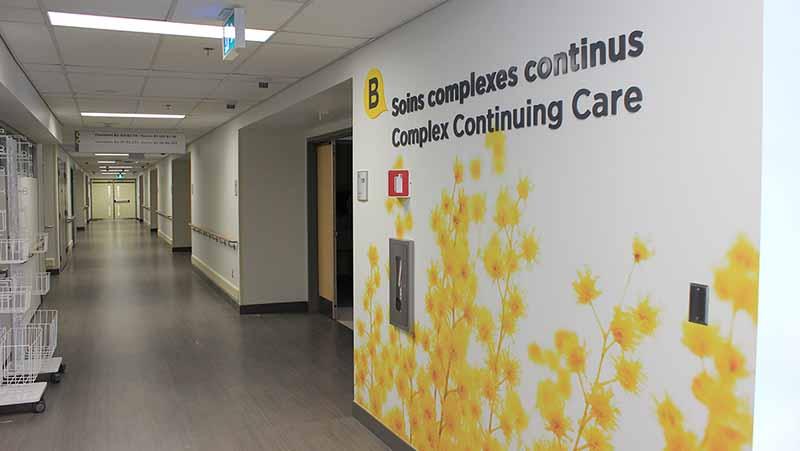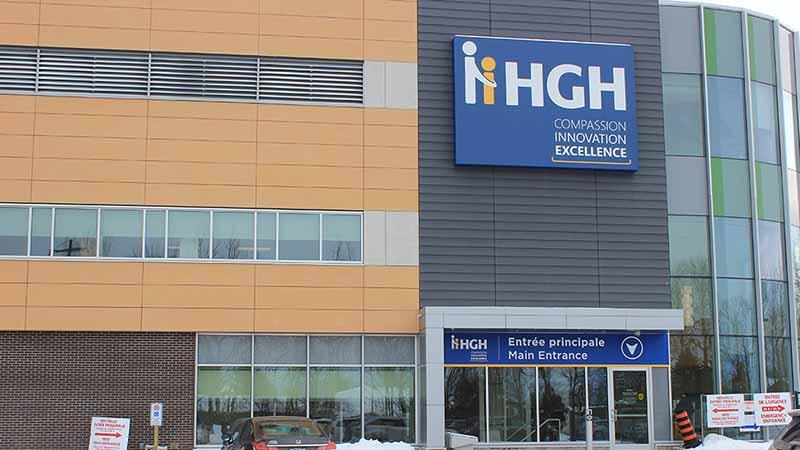Hawkesbury and District General Hospital (HGH) opened the doors of the ambulatory clinic to patients in the newly-built three-storey building on Monday, January 22 2018. The new temporary main entrance is located on the west side of the hospital. The new state-of-the-art building houses the Medical Day Unit, Ambulatory Clinics, Hemodialysis, Outpatient Rehab, Complex Continuing Care and administrative offices.
“The opening of this new building featuring state-of-the-art infrastructure, medical equipment and technologies is bringing us closer to becoming a model hospital in Ontario by 2020. We are looking forward to the opening of the new Emergency Department,” states Marc LeBoutillier, Chief Executive Officer in a press release.
Patients can walk in and register at the self-serve stations located in the front. Volunteers and staff are always present to help patients register. Once registered, patients are given a plastic puck that will vibrate once it’s their turn to be seen by a clinic. This system is also used in restaurants when people need to wait to be seated.
First Floor

The waiting room is spacious and has multiple TV screens that will show information to guide patients to the right clinic and room. (photo: Maxime Myre)
A major part of the first floor is reserved for the waiting room. The waiting room is spacious and has multiple TV screens that will show information to guide patients to the right clinical room. It will also show the name of which doctor occupies which room. The rooms have now been all standardized and are identical to one another. The purpose behind this is so that doctors, who come in on a weekly or monthly basis, can familiarize themselves with the environment and come back a week later in any room and still know where everything is, allowing for a more simple rotation for the medical staff.
The hemodialysis clinic, a satellite clinic of the Ottawa Hospital, has gone from eight stations to twelve. The area is much bigger and there is also a parking and charging station for medical scooters. There are no walls between stations, only curtains, because the thinking is that patients requiring hemodialysis treatment are there so often that some of them have bonded over time and often like to socialize while having their treatment.
Second floor

On the second floor is the Complex Continuing Care for longer-term treatments. (photo: Maxime Myre)
On the second floor is the Complex Continuing Care for longer-term treatments. There are 24 rooms that house one patient at a time. The rooms are spacious and are all equipped with a lift. The bathrooms are all wheelchair-accessible as are the showers. Patients occupying these rooms are hospitalized for a minimum of 21 days. The large rooms allow family members to visit and stay by the patient’s bedside comfortably while medical staff have enough space to work on the patient.
Large windows have been placed so that patients can have some sunlight. A large common dining room is also available to patients so they can socialize during the day. A terrace that will be filled with vegetation is also accessible from the dining room. The main corridor is equipped with alcoves for storing food trolleys and wheelchairs. There is also and isolation room for patients with fragile immune systems. A physiotherapy is also accessible on the same floor for recovering patients.
Basement

Physiotherapy room at the new HGH building. (photo: Maxime Myre)
The basement of the building includes several rooms for employees, including conference rooms and lockers. The main purpose for this floor is for physiotherapy treatment. Large open rooms are used as gyms and can house multiple patients at a time. Nine closed treatment stations are also available to patients. Large windows have been installed to let sunlight in so it doesn’t feel like you are in a basement.
The move
All external clinics such as the diabetes clinic, and the foot clinic which are currently not in the hospital are going to be back once the construction is completed. The HGH foundation, currently located on Main Street, will also be moved to the hospital. The challenge with the $160-million redevelopment project is that the hospital keeps running 24/7, 365 days a year. Moving services around is a meticulous operation as to not disturb patients and still have the optimal protections against the spread of infection, which is why HGH is taking all the precautionary measures and moving services one by one.
Over the winter, the entrance to the visitor parking will also change location, moving onto Ghislain Street, behind the Trillium Building, just west of the present entrance on Duplate Street. It will feature new gates and a new electronic pay station system. Starting in February, users will have the option to pay for parking by debit, credit or cash, through electronic pay stations located indoors and at the parking exit. Parking fees will change from $4 to $5 per visit.
“The redevelopment project is having positive impacts on medical practice. The leading-edge technology and medical equipment really helped us in bringing new specialists at HGH. For our patients, this means better access to care, closer to home,” said Dr. Julie Maranda, Chief of Staff.
Opening dates of departments in their new premises
o Medical Day Unit – Opened
o Ambulatory Clinics – Opened
o New temporary Main Entrance – Opened. Entrance will be open from 6:30 am to 8:00 pm. After 8:00 pm, patients and visitors must use the Emergency Entrance.
o Telemedicine – January 29
o Cardiology – January 29
o Specimen Collection Centre – January 29
o Hemodialysis – January 29
o Outpatient Rehab – February 5
o Complex Continuing Care (inpatient unit) –February 15
Emergency and Intensive Care Unit – late Winter


